I wish to determine when a point (mouse position) in on, or near a curve defined by a series of B-Spline control points.
The information I will have for the B-Spline is the list of n control points (in x,y coordinates). The list of control points can be of any length (>= 4) and define a B-spline consisting of (n−1)/3 cubic Bezier curves. The Bezier curves are are all cubic. I wish to set a parameter k,(in pixels) of the distance defined to be "near" the curve. If the mouse position is within k pixels of the curve then I need to return true, otherwise false.
Is there an algorithm that gives me this information. Any solution does not need to be precise - I am working to a tolerance of 1 pixel (or coordinate).
I have found the following questions seem to offer some help, but do not answer my exact question. In particular the first reference seems to be a solution only for 4 control points, and does not take into account the nearness factor I wish to define.
Position of a point relative to a Bezier curve
Intersection between bezier curve and a line segment
EDIT: An example curve:
e, 63.068, 127.26
29.124, 284.61
25.066, 258.56
20.926, 212.47
34, 176
38.706, 162.87
46.556, 149.82
54.393, 138.78
The description of the format is: "Every edge is assigned a pos attribute, which consists of a list of 3n + 1 locations. These are B-spline control points: points p0, p1, p2, p3 are the first Bezier spline, p3, p4, p5, p6 are the second, etc. Points are represented by two integers separated by a comma, representing the X and Y coordinates of the location specified in points (1/72 of an inch). In the pos attribute, the list of control points might be preceded by a start point ps and/or an end point pe. These have the usual position representation with a "s," or "e," prefix, respectively."
EDIT2: Further explanation of the "e" point (and s if present).
In the pos attribute, the list of control points might be preceded by a start point ps and/or an end point pe. These have the usual position representation with a "s," or "e," prefix, respectively. A start point is present if there is an arrow at p0. In this case, the arrow is from p0 to ps, where ps is actually on the node’s boundary. The length and direction of the arrowhead is given by the vector (ps −p0). If there is no arrow, p0 is on the node’s boundary. Similarly, the point pe designates an arrow at the other end of the edge, connecting to the last spline point.


